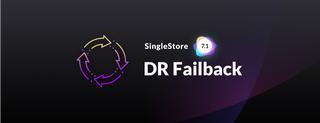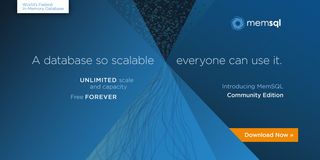
If you haven’t noticed, the cloud database market is on fire. You’ll definitely feel the heat when you check out the recently released Cloud Database Report 2022 & Top 20 Vendors, an impressive list that includes SingleStore. In this post we explore the report, key attributes buyers should be looking for in a cloud database and why SingleStore makes the cut.
Capturing the excitement
John Foley is a busy guy. On top of a long run as a tech journalist covering the database industry, he’s the host of the Acceleration Economy’s Data Revolution Channel, where he delves into all aspects of modern data management. He’s also Founder and Editor of the Cloud Database Report, where he doesn’t waste a minute in capturing the excitement sweeping our high-growth industry. He kicks off the 2022 report with:
In December, I reported that 10 database startups … received a total of more than $2.9 billion in funding in 2021. [Including SingleStore, which received $80 million in Series F funding in September.] … This near-frantic pace of funding and development causes me to say that the 50-year-old database market is going through a Renaissance. It’s not your father’s (or grandfather’s) relational DBMS managing data in tables and rows on servers in data centers. Cloud databases are the beating heart of the data-driven digital enterprise.
SingleStoreDB is definitely not Larry Ellison or Mark Hoffman’s database. We are, however, one of the 20 cloud database providers that Foley chose as leaders, representing a cross section of the database market: incumbents, public cloud providers and challengers.
5 factors determine cloud database leaders
Foley sets the stage as he gets into his analysis: “As you would expect in this fast-changing market, a few newcomers have joined the Cloud Database Top 20 this year, while others have dropped off. New on the list are PlanetScale, SingleStore, and Yugabyte. Gone are Cloudera, MarkLogic, and Vertica. You will find the complete Cloud Database Top 20 below, with my take on each vendor.”
In addition to basic Darwinism — challengers are displacing incumbents — Foley’s Top 20 reflects a significant change to the criteria for being included on the list. “This year,” he writes, “I have added ‘cloud native’ as a determining factor.”
These five considerations now comprise Foley’s Cloud Database Top 20 criteria:
- Cloud-native architecture. The cloud database services are designed to work across hybrid and multi-clouds, and integrate with other cloud-based infrastructure.
- Enterprise capabilities. Vendors with a complete range of services and support that enterprises may want or need. Fully managed services are a plus.
- Platform adaptability. Tools, services and APIs for data integration/migration and application compatibility are must-haves.
- Innovation. A steady pipeline of new, modern, differentiating capabilities.
- Demonstrated business value. Customer success is the No. 1 proof point.
How many contenders are there for the Top 20? As a reference point, Foley notes that “innovation is thriving in the database market. One point of reference is Carnegie Mellon University’s Database of Databases, which at last count provided an archive of 795 different database management systems. And that number is growing.”
Why SingleStore stands out
“With so many databases to choose from,” he continues, “it underscores the importance of a data architecture that fits the pieces together in support of the business strategy.” Clearly, SingleStore has the right stuff. In the league table containing the Top 20 Foley says of SingleStore:
- “Differentiators: Multi-model SQL database supports transactions, analytics, various data types
- “My take: Emphasis on ‘data intensity’ and converged workloads in one system is compelling”
Learn more about data intensity from our white paper, “Data-Intensive Applications: A C-Suite Guide.”
SingleStore also fulfills the key architecture requirements Foley lays out:
“An adaptable data architecture—featuring cloud-native databases, data distribution, resilience, and security—is essential to modern data management. A few of the key capabilities to look for in cloud databases include:
- Multiple deployment options - hybrid, multi-cloud, edge, on premises, mobile.
- Data distribution - capabilities that support data distribution across regions and availability zones include replication, geo-partitioning, change data capture, data streaming, APIs, and prebuilt connectors.
- Managed services and automation - some cloud databases are self-managed by the user, while others are fully managed by the service provider. In addition, cloud databases are increasingly offered with some level of automation, such as serverless provisioning, auto-sharding[.]”
SingleStore enables effortless migration
The Cloud Database Report 2022 covers a number of topics, including Data Platforms & Data Clouds, Purpose-built vs. All-purpose, and Migration. Of the latter Foley writes:
“Database migrations get more complicated when they involve different source and target databases—say from an Oracle database to PostgreSQL—or when there are hundreds of terabytes to move. That’s because these projects often involve more than just the data; there are custom code and applications tied to those data sets. And full-scale data warehouses represent an even bigger lift.
In fact, it can take weeks, months, or even years to move a company’s “data estate” from one database environment to another. In one case study, AWS said it took two years to move 7,500 Oracle databases with a total of 75 petabytes of data, used by Amazon.com, to AWS’s own Aurora and special-purpose databases. [Emphasis added.]
Migration scenarios include application modernization, data governance (such as locating data in a specific country), and offloading mainframe or other legacy workloads to the cloud. But the starting point for many IT teams is new development.”
In fact, SingleStore excels at migration, a benefit that telegraphs straight to the hearts and minds of the engineers and developers who choose SingleStore as a core technology. Here’s an excerpt from our eBook “Ludicrously Fast Analytics: A 5-Step Guide for Developers of Modern Applications,” based on three top app developers’ experiences with SingleStore.
Database migration is scary because it’s risky. Migration weighs heavily on developers’ minds as they evaluate new solutions, because their business, reputation and sanity are all on the line.
Luckily, Josh sidestepped migration completely. SingleStore is wire-compatible with MySQL, so IEX Cloud was able to “just get it up and running, and do a one-to-cone comparison with what we already had in our system because it didn’t require any code,” he said. “Ultimately, choosing [SingleStore] meant that we didn’t have months of migration time. There’s a lot of tools and support already out there in the community.”
Fathom’s migration, on the other hand, was a 10-day marathon planned with a military level of precision. Jack detailed every step of the process in his blog, including code snippets. Here’s an abbreviated version of his migration story, which came off without a hitch:
This isn't my first rodeo. I've migrated countless high-value projects in the past. And even within Fathom, we've already done multiple migrations…But this migration was different because of the size of the data. We were dealing with hundreds of millions of rows, consisting of many billions of page views.
After finishing the migration [to SingleStore], we were partying big time. This was months of work, doing research, implementations, and so much more. We couldn't believe we were finally migrated into a database system that could do everything we needed and was ready to grow with us. I spent the next few days watching the server metrics to ensure nothing would go wrong, and it was beautiful.
As you can see, there are lots of reasons why SingleStore is winning hearts, minds and accolades across a wide swath of the global cloud database community. Check out The Cloud Database Report 2022, read our developer eBook and get started with SingleStore today.
Try it for free.
.png?auto=webp&width=320&disable=upscale)



